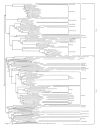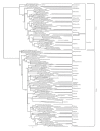Phylogenomic investigation of phospholipid synthesis in archaea
- PMID: 23304072
- PMCID: PMC3533463
- DOI: 10.1155/2012/630910
Phylogenomic investigation of phospholipid synthesis in archaea
Abstract
Archaea have idiosyncratic cell membranes usually based on phospholipids containing glycerol-1-phosphate linked by ether bonds to isoprenoid lateral chains. Since these phospholipids strongly differ from those of bacteria and eukaryotes, the origin of the archaeal membranes (and by extension, of all cellular membranes) was enigmatic and called for accurate evolutionary studies. In this paper we review some recent phylogenomic studies that have revealed a modified mevalonate pathway for the synthesis of isoprenoid precursors in archaea and suggested that this domain uses an atypical pathway of synthesis of fatty acids devoid of any acyl carrier protein, which is essential for this activity in bacteria and eukaryotes. In addition, we show new or updated phylogenetic analyses of enzymes likely responsible for the isoprenoid chain synthesis from their precursors and the phospholipid synthesis from glycerol phosphate, isoprenoids, and polar head groups. These results support that most of these enzymes can be traced back to the last archaeal common ancestor and, in many cases, even to the last common ancestor of all living organisms.
Figures




References
Publication types
MeSH terms
Substances
LinkOut - more resources
Full Text Sources

